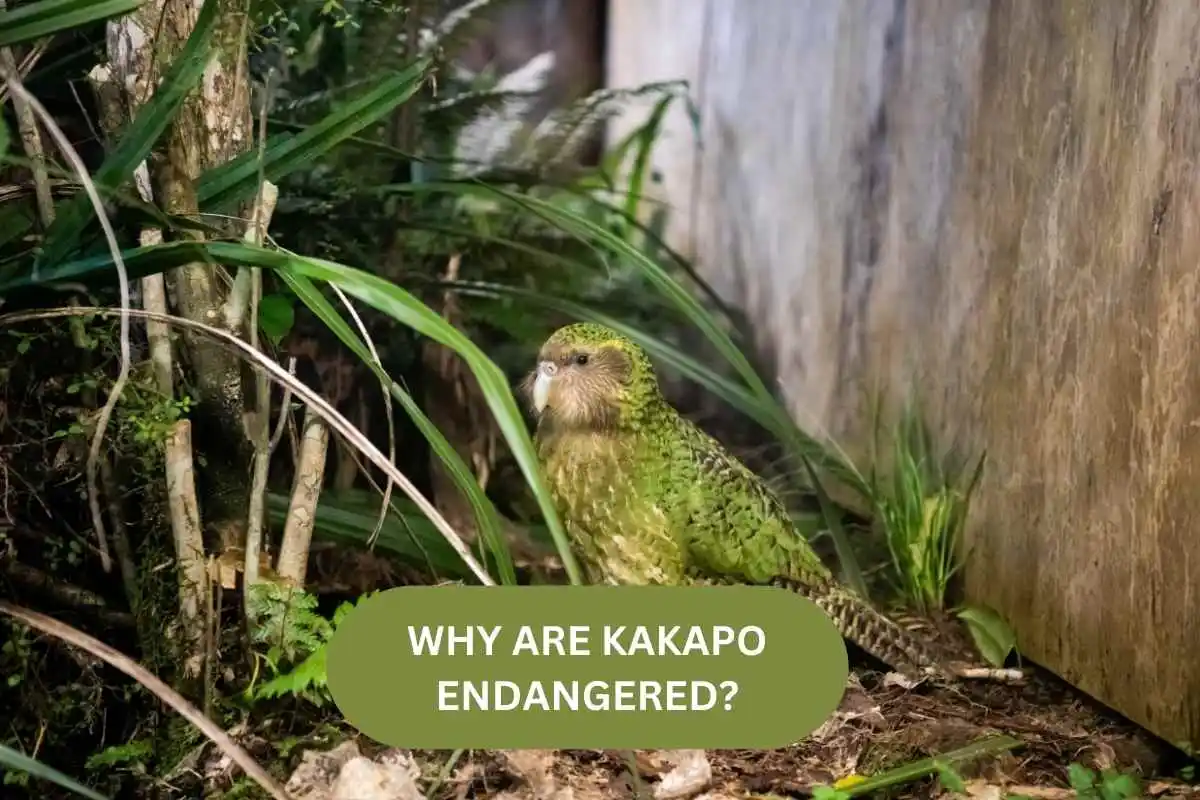The Kakapo is a unique and fascinating bird species, but unfortunately, it is also endangered. As a pet enthusiast, you have likely come to know the importance of preserving and protecting our planet’s wildlife. Kakapo’s population decline is due to many threats that have resulted in its decline.
Why Are Kakapo Endangered? Kakapos are endangered due to a combination of factors, including habitat loss, the introduction of predators such as stoats, and genetic issues within their small population. The species was also impacted by overhunting by humans in the past.
In this article,I will explore the reasons behind Kakapo’s endangerment and discuss what can be done to protect it. By understanding its challenges, we can work together to ensure its survival for future generations.
Why did Kakapo go extinct?
Kakapo go extinct because of many reasons such as:
- Loss of habitat
- Introduction of predators such as stoats.
- Overhunting by humans in the past.
Small population size also reduced genetic diversity, made the species more vulnerable to diseases and other threats, and limited their ability to adapt and evolve in response to changing conditions.
Despite conservation efforts, including predator control, habitat protection and restoration, and breeding programs, the Kakapo remains one of the most endangered species in the world.
Conservation efforts to save the Kakapo include monitoring and managing populations, predator control, and genetic management to ensure the species’ long-term survival.
What are the threats to Kakapo?
The following are the major threats to the survival of the Kakapo:
- Introduction of mammalian predators such as stoats, rats, and possums.
- Loss and degradation of habitat due to deforestation and the spread of agriculture.
- Inbreeding and small population size lead to reduced genetic diversity and increased vulnerability to diseases and other threats.
- Climate change and its impacts on the Kakapo’s habitat and food sources.
- Human disturbance, such as trampling or disturbance of nests during breeding seasons.
- Natural disasters, such as severe weather events or disease outbreaks.
- Limited genetic diversity and low reproductive success make the species more vulnerable to future threats.
- Lack of genetic management and monitoring of populations.
- Competition for resources with other wildlife species.
- Inadequate funding for conservation efforts and management of Kakapo populations.
How many kakapos are left in the world?
The estimated number of Kakapo remaining in the world was around 200 individuals.
The Kakapo is one of the rarest and most endangered species worldwide, and ongoing conservation efforts are crucial for its survival. The exact number of Kakapo may change as conservation efforts, and monitoring programs continue, and updated information may be available from relevant conservation organizations.
Is the kakapo the rarest animal?
The Kakapo is one of the rarest species of birds in the world, but it is not necessarily the rarest animal. Many other animals—such as the northern white rhinoceros and mountain gorillas—also have small populations and are at risk of extinction. The exact ranking of these species can vary based on different criteria, such as available data.
The Kakapo’s combination of flightlessness and low population makes it one of the world’s most unique and endangered species.
Genetic Issues in Kakapo Population
The endangered status of the Kakapo is the result of genetic issues. Over many generations, the small population size and limited genetic diversity of the Kakapo have resulted in inbreeding and a loss of genetic diversity. This reduced genetic diversity has increased the species’ vulnerability to diseases and other threats and limited its ability to adapt and evolve in response to changing conditions.
Inbreeding in populations has resulted in the expression of harmful recessive traits, such as reduced fertility and increased susceptibility to diseases. To address these genetic issues, conservation efforts have included the management of populations through breeding programs that aim to increase genetic diversity and reduce inbreeding. These programs include using assisted reproduction techniques, such as artificial insemination, and selecting breeding pairs based on their genetic compatibility.
Genetic monitoring and management are essential for the survival of the Kakapo population, as they help ensure that this species remains healthy and resilient in the face of future challenges or threats.
Kakapo Recovery Program and its Successes
The Kakapo Recovery Program is a collaborative effort between the New Zealand Department of Conservation and various non-government organizations to conserve and recover the endangered Kakapo population. The program was established in the 1990s, and its strategies include habitat protection and restoration, predator control, and breeding and genetic management programs.
The Kakapo Recovery Program has achieved several successes over the years, including:
- Increased population size: Thanks to intensive management and breeding programs, the Kakapo population has increased from 50 individuals in the 1990s to 200 or more as of 2021.
- Habitat protection and restoration: The program has protected and restored critical Kakapo habitats, including offshore islands and mainland sites, to provide a haven for the species.
- Predator control: The use of trapping and baiting has helped reduce the impact of mammalian predators on the Kakapo population.
- Improved genetic diversity: Genetic diversity and reduced inbreeding have been increased within the Kakapo population through breeding and genetic management programs.
- Increased public awareness and support: The Kakapo Recovery Program has raised public awareness and support for the conservation of endangered species in New Zealand.
The Kakapo is an example of how intensive conservation efforts can help protect endangered species, even when they are facing threats. However, there is still much to be done to ensure survival in the long term for this unique and endangered species.
Inadequate funding for conservation efforts and management of Kakapo populations
A significant challenge for the conservation and management of Kakapo populations is inadequate funding. Conservation and management efforts, including habitat protection and restoration, predator control, breeding and genetic management programs, require significant resources and financial support.
However, limited funding can limit the effectiveness of these efforts and hinder progress towards the recovery of the Kakapo population.
The lack of funding can also have a negative impact on the ability to conduct research and monitor programs that are critical for understanding the species’ biology and ecology, and for developing and refining conservation strategies.
Furthermore, limited funding can impact the ability to hire and retain skilled personnel, who are essential for implementing and managing conservation programs.
To help ensure the survival of the Kakapo, we must provide funding for the conservation and management of this species.
Financial support from governments, non-government organizations, and the public is needed to provide the resources necessary to protect and restore its habitat and implement effective breeding programs. By supporting conservation efforts we can help secure a future for this endangered species.
Did I answer your query about why are Kakapo endangered?
The survival of the Kakapo is precarious, and ongoing monitoring and management are necessary to ensure its persistence in the future.
It is crucial to raise public awareness and support for the conservation of endangered species, as they play a crucial role in maintaining diversity on our planet and contributing to ecosystems. We can help secure a future for endangered species by working together and supporting conservation efforts.

